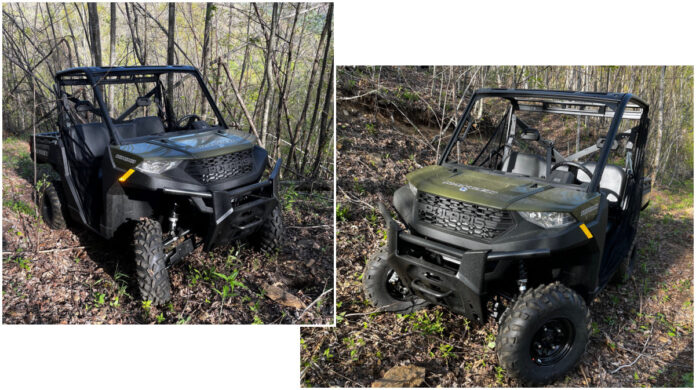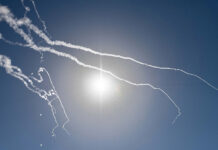As you can see from the photo, we not only got our Ranger Polaris side-by-side, but I promptly threw it into all-wheel drive and drove it up the steepest part of the mountain. If it would not make it, I wanted to know right away.
Happily, it made it up the steep slope with ease, and there was only one clunk when I drove over a rock that hit something it probably shouldn’t have. The bottom has skid plates, so hopefully, no harm done. Even more happily, I brought a chain saw, because I had to clear some downed trees to reach to a place where I could turn around. The idea of going down backwards was a bit intimidating, so I was glad I didn’t have to. Driving down the mountain forward turned out to be easy. In low gear, the Ranger’s engine breaking holds it back to 2 or 3 mph, which I found both impressive and useful
Overall Thoughts and Impressions
I have less than 10 miles on the odometer, so this is subject to change, but my initial impressions are mostly positive:
- Compared to the 2017 Crew model (two rows of seats) we borrowed from our neighbor, the engine is stronger, smoother and quieter in my new Ranger. I’ve only been on dirt roads and haven’t taken her faster than 23 mph, but the engine sounds less like a lawn mower and more like a car.
- I let the same neighbor drive it, of course, and he was impressed by the power steering. The Ranger is small enough to be manageable without the power steering, but its presence makes a noticeable difference. When you are trying to make a four or five point turn on a narrow path, the power steering is a big help!
- At some point, Polaris got rid of parking brakes and added a “park” setting to the transmission. Because I will park on a steep hill more often than on level ground, this did not sit well with me. I don’t want to rely on the transmission to prevent it from rolling away, and I’d rather not jump out and throw a set of chocks behind the wheel every time I stop.
The dealer recommended a device called the “Spring Brake Thingy,” and I got them to throw it in as part of our negotiations. It is a third-party manual device that holds the brake pedal down, giving you a parking brake. - This model also has more storage and a nicer dashboard/front end than the older model. It also features a simple system for attaching accessories you add to the power system. I will use it when I add a winch and a small light bar.
Carrying Tools and Supplies
When I showed my wife the storage spaces, she looked at the bin under the seat and said, “Are you going to put a gun in there?” Ah, she knowns me so well! But no, I don’t plan to store a gun in there. I do, however, plan to keep some loaded magazines and spare ammo in there. You know, just in case. There are six cup holders, also an upgrade from the earlier model years, but I will toss some water bottles in the open bins under the dashboard where they are less likely to fall out.
My plan is to build wooden rails that extend the height of the bed to allow me to carry more firewood. I will also add some protection to prevent chunks of firewood, or whatever else is back there, from flying forward and hitting me or a passenger if I slam on the brakes. If I can work it out, I’ll add a tool box on the upper portion of the rail, or find some way to strap a chainsaw in place. A way to attach a shovel or spade would also be useful. Those are the two tools I think I would need most.
The vehicle has two “power ports,” which is the politically correct term for what we used to refer to as cigarette lighters. My plan is to plug a USB adapter that features two USB-A ports and one USB-C port into one of them. I am surprised Polaris isn’t including these ports yet, seeing as so many things use USB power these days. I don’t foresee desperately needing the USB ports, but it will be convenient if I need to charge my phone, a headlamp, flashlight, camera, walkie-talkie, or anything else I bring with me.
This Gives me Options
While I was driving up the mountain on our steep, overgrown logging road, I thought, “Boy, this sure as hell beats walking.” OK, granted, I knew it would, but the ability to shoot up the mountain in minutes with two people and a couple hundred pounds of cargo opens up so much more of our 20 acres than we are utilizing today. It makes me wish I had bought it years ago. Oh well, hindsight is 20/20.
From a prepping standpoint, not only will this UTV give us the ability to get down the mountain if the road and/or ford get washed out again, it will:
- Increase our ability to harvest firewood from our land and improve our forest by weeding out some junk trees to allow the cherry, oak, maples and hickory to grow.
- Put a few beehives in a new, remote location where they are effectively hidden.
- Make it easier to plant fruit trees in areas that are difficult to reach.
- Give us access—in a world without the rule of law—to a network of old logging roads to harvest deadwood on adjoining properties.
- Similarly give us access to a much wider area for gathering wild food, hunting and scouting if the absentee property owners of some properties do not manage to bug out here after a SHTF event.
- Allow us to get down the mountain after a heavy snow should one of us or a neighbor need medical treatment during inclement weather.
- Zip down the mountain and offer reinforcements to the neighbors if they come under attack from marauders in a WROL situation.
- Make it easier to bug out up and over the mountain via the Ranger (rather than walking) in a SHTF event or if we come under attack
- Also allow me to place larger, heavier and more emergency caches on our property and in the surrounding area because I no longer need to backpack them into place.
As you can see, I am excited about the opportunities this UTV opens up, both for regular non-emergency use, as an alternative mode of transport, and to boost our preparedness.







